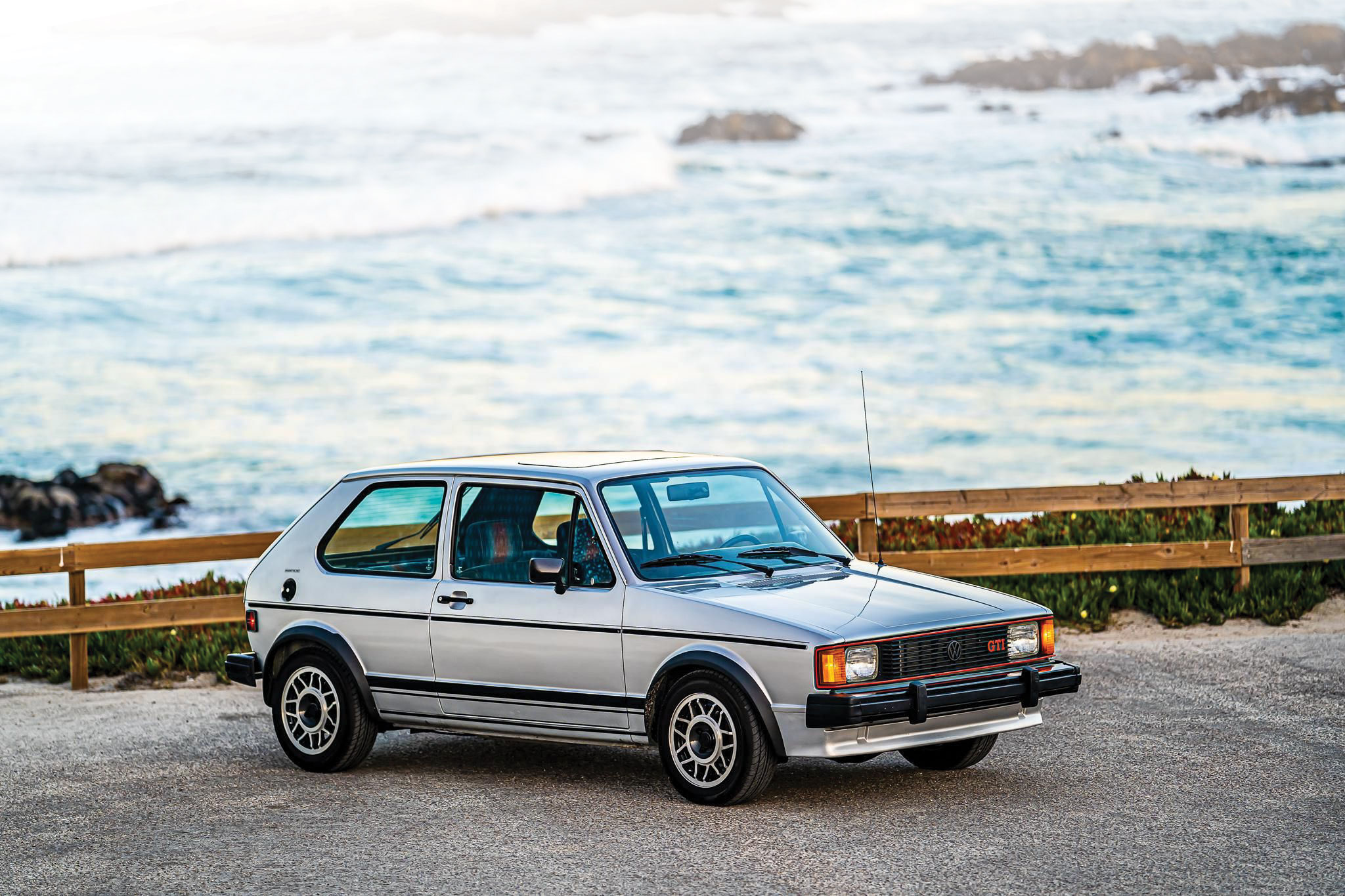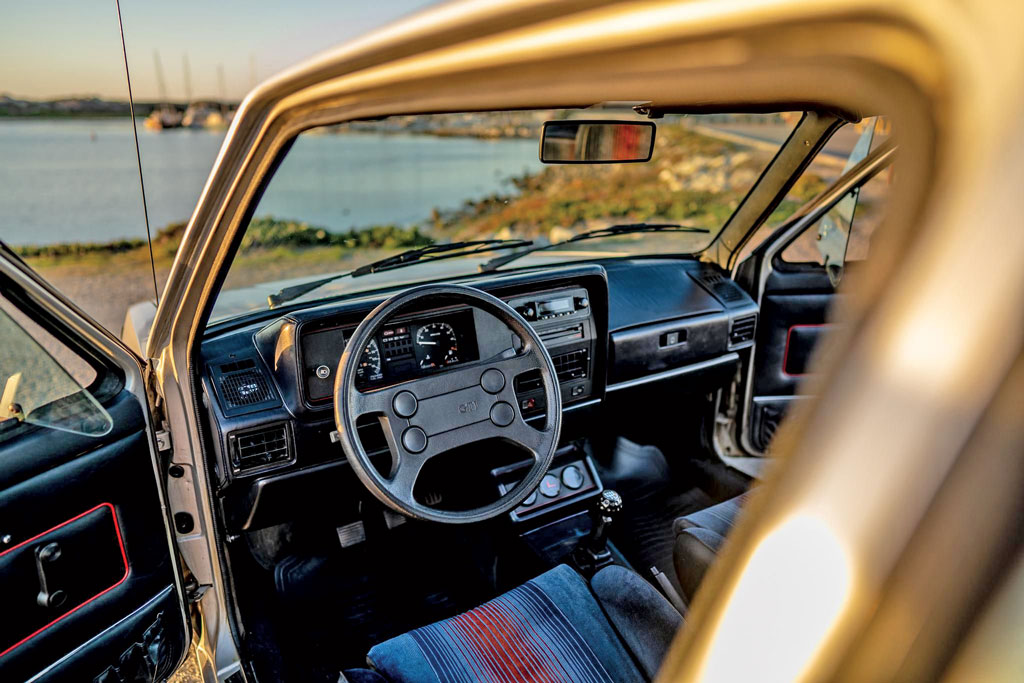
It takes some guts to walk away from everything that made your car company great, but that’s what Volkswagen did in the early 1970s. The 1974 Rabbit (or Golf, depending on your continent) was the replacement for the antiquated air-cooled Beetle. The all-new A1 platform was a complete departure for Wolfsburg, abandoning everything about the Beetle except the VW logo. Giorgetto Giugiaro’s Italdesign gave the Rabbit (and its Scirocco, Jetta and Dasher stablemates) a squared-off look with sharp creases and mostly flat panels.
A transversely mounted, water-cooled engine in a front-drive configuration was similarly up to date, if underpowered. In the name of fuel economy, VW management had decreed a series of lackluster engines that never lived up to the lively promise of the Rabbit name. However, as so often happens, a small cadre of German employees led by Hermann Hablitzel, Board Member for Technology, immediately began work to rectify that problem. In one of the great moments of doing it right, VW’s board approved the project, creating the first GTI models for the European market by 1976.
The GTI formula was simple: a more-powerful fuel-injected engine, performance-tuned suspension and the best brakes available, all in a lightweight, no-frills package. VW initially approved 5,000 units, but the GTI was so popular that it ended up making over 460,000 units for Europe and Canada through 1983. The “hot hatch” had arrived.

Made in the USA
Typically, the GTI was a late arrival in the United States. Sales started here in late 1982 as 1983 model-year vehicles. The American GTI was, in fact, American-made (in Westmoreland, PA), but with a different engine and about 300 extra pounds compared to the home-market version. But this was not all bad.
For the U.S., VW used a lower-compression version of the 1.8-liter SOHC 4-cylinder engine. Fuel delivery was by Bosch CIS, and the camshaft from the standard 1.7-liter Rabbit was retained. This is why the U.S.-spec GTI had 90 horsepower while the Euro version made about 110. While the Euro GTI had more power on paper, it was high-strung and notorious for its lack of mid-range grunt. The American GTI engine pulls strongly and happily up to 5,500 rpm.
In U.S. trim, the GTI could hustle its 2,072-pound curb weight from 0 to 60 mph in a little more than nine seconds, which was not bad for small sports cars of the day. The close-ratio 5-speed manual gearbox was great for an autocross or twisty mountain road, but it was a little short for high-speed cruising on the freeway.

Simple yet sporty
Looking underneath the GTI, you wouldn’t guess it could be so nimble. The front suspension is a standard MacPherson strut setup. The GTI really needs a lower chassis brace connecting the two sides to tighten things up (an upper strut brace helps, too). Luckily, these were readily available from various aftermarket suppliers. The rear suspension is primitive, with a stamped U-shaped torsion-beam axle and a pair of coil springs to keep the rear bumper from dragging on the ground.
Even so, the GTI caught the right balance of handling. It was prone to a little understeer in stock configuration, but you could dial that to a slight preference for tail-wagging with an aftermarket rear sway bar. Plus, it looks sporty when you trail brake into a corner and the GTI lifts its inside rear wheel like a golden retriever at a fire plug.
Not being fools, VW gave the GTI some at-a-glance distinguishing traits. Black wheelarch flares, black window frames, a thin red line around the grille, plus some attractive “snowflake”-design alloy wheels let everyone know you’re driving the hot version. Inside, the GTI was sufficient for the day. It was simple, comfortable and offered great visibility. You could easily commute in a GTI during the week, carry the family to grandma’s, and fold the rear seats down to haul your autocross tires on the weekend.
The Mk1 GTI was made for just two years before being replaced in 1985 by the Mk2 version, which was larger, softer and could be had with a 16-valve engine. However, the A1 Rabbit platform lived on through 1994 in the form of the VW Cabriolet. It’s not widely known, but the convertible Rabbit also carried the GTI driveline and chassis.

Goin’ Rabbit hunting
The GTI is a hardy creature. Regular maintenance of rubber parts, including the O-rings that seal the fuel injectors into the head, is frequently deferred and can lead to rough running. Brakes, clutch, struts, and other components will benefit from attention now that the cars are about to hit the big 4-0. Parts availability remains good; even aftermarket suspension add-ons are available on eBay at throwaway prices.
A year or two ago, we would have said that a savvy buyer could find a good GTI by scanning Craigslist, but those days are gone forever. As with so many newer collector cars, Bring a Trailer and other online auctions are the place to look. Apart from a few outliers, expect to pay $10k–$15k for a decent American Mk1 GTI. Last October, a super clean single-owner example in black brought a $41,000 sale price, but that’s not the norm — at least not yet. ♦